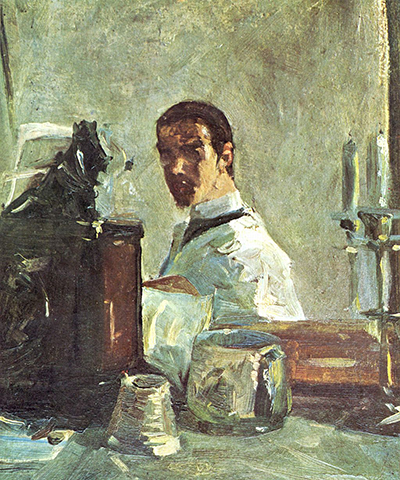This self portrait was produced by Henri de Toulouse-Lautrec in 1882-1883. It offers an insight into how he saw himself, when normally he would be focusing on other people.
The artist is dressed in a white shirt, with a dark section being either a loose tie or a feature of his collar. The brushwork here is loose and expressive, typical of the impressionists, with whom the artist was well acquainted. He looks directly at us, with smart, slick hair and a well shaved appearance. Beside the mirror is a candle stick holder plus some other items which fill this table top. We are seeing a small part of his own bedroom, perhaps, and he makes no attempt to tidy it especially for this work. Toulouse-Lautrec was an honest artist who tended to paint things just as he saw them. He may well have completed this piece relatively quickly because of how many of the oil touches are not overly blended in, leaving an impression of imagery rather than something more akin to realism.
Light is an important component of this artwork, coming as it does in from our right hand side. His shoulder nearest us is drenched in light, bringing brightness to his shirt. There is a small dabof white paint on his forehead, plus further touches to the side of the candle and on some reading materials which lay just in front of him. One can get a good impression about the artist through this work, such as his manner of dress, his attention to personal grooming, and also how he might lay out his own room. His expression is confident and serious, just as he would depict most who sat for him. There can often be a difference between how an artist wanted to be viewed, and how he actually came across to others in real life, just as with the rest of us.
This self portrait is relatively small, at 40cm tall by 32cm wide. It was produced on cardboard, rather than a canvas, perhaps explaining why some of the brushwork was so quick and loose. It is now a part of the Musée Toulouse-Lautrec, Albi, which might suggest that the artist's mother had included this work when donating many items to the new museum. We must remember that self portraits were rare for this artist, meaning this piece holds particular importance. We can notice how he leaves his lower half out of this work, hiding his disabilities from the viewer.




